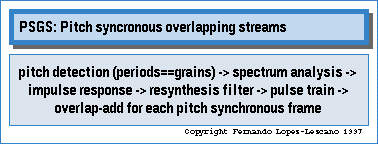
"All sound is an integration of grains, of elementary sonic particles, of sonic quanta." -Xenakis (1971).
intro | technique | parameters | uses | progs
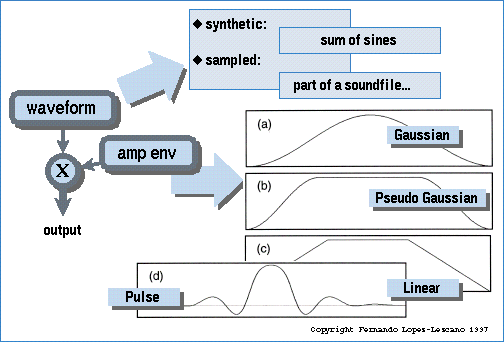 (fig.1)
(fig.1)
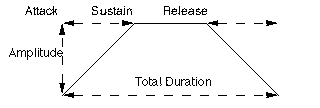 (fig.2)
(fig.2) -
One of the first composers to develop a method for composition with grains was Iannis Xenakis. His method is based on the organization of the grains by means of screen sequences . The first compositions to use this method were Analogique A, for string orchestra, and Analogique B, for sinusoidal sounds, both composed in 1958-59.
At this moment all of the main features and parameters of granulation of sound files have been covered (see parameters ) . What remains, however, is the musical approach to those parameters in order to be able to manipulate and organise grains in a musically predictable fashion. To put the situation of granular reconstruction of sound files in perspective one must underpin the most important parameters in such process. Firstly, the question of frequency-spectrum specification as far as granulation of sound files is concerned, is provided automatically by the spectrum of the input sound file (i.e. original sound source) and consequently does not need much of research at this stage. The only two factors that are left to make a big impression on the granular process are density and length of grains.
For example, it is quite basic to expect that a short length of grains will result in a high level of sound cropping thus making even the sustain strings brake down into percussive elements . It is also quite logical to consider that the addition of a certain density value will create a repetitive succession of those percussive elements consequently resulting in a pulse signal . Now, if the effects of length and density were not dependent on each other, one could presume that by changing density one could create a pulse signal with modulated pitch/frequency (the value of which is proportional to density). In practice however, the change of density would result not only in higher rate of grain's repetition, but also it will change the gaps between consecutive grains and in the extreme case the sound will loose it's percussive element all together as grains will overlap (the case of "reconstruction" of original sound is highly relevant here).
In other words this example shows that by changing density not only the expected effect takes place (i.e. change of pulse frequency), but also there is a "side effect" present (i.e. a change in balance between original and granulated sounds). What is needed, however, is an exclusive association between a certain parameter and its' effect in the process of granulation. As the result of such logic, the remaining part of this work represents a proposition for new variable/coefficient in order to suffice the relative dependency between grain's length and density... A new coefficient could be introduced if one is to look at the granulation of sound from a point of view where control of "musical" predictability of the effect are of outmost importance. Such coefficient does not include any new functionality to the granular processing of sound, rather it represents a certain method by which one can manage the already existing parameters of the granular effect (namely density and duration).
Also very imporant for the sound of the granulation is the type of granular synthesis . Here are some types of granular synthesis :
Pitch-synchronous granular synthesis (PSGS) is an infrequently performed analysis-synthesis technique designed for the generation of pitched sounds with one or more formant regions in their spectra (Roads 191). It makes use of a complex system of parallel minimum-phase finite impulse response generators to resynthesize grains based on spectrum analysis.

Quasi-synchronous granular synthesis (QSGS) creates sophisticated sounds by
generating one or more "streams" of grains (figure 3). 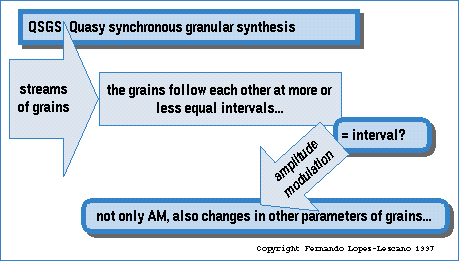 (fig.
3)
(fig.
3)
When a single stream of grains is synthesized using QSGS, the interval between the grains is essentially equal. The overall envelope of the stream forms a periodic function. Thus, the generated signal can be analyzed as a case of amplitude modulation (AM) . This adds a series of sidebands to the final spectrum. By combining several QSGS streams in parallel it becomes possible to model the human voice. Barry Truax discovered that the use of QSGS streams at irregular intervals has a thickening effect on the sound texture. This is the result of a smearing of the formant structures that occurs when the onset time of each grain is indeterminate.
1. Start time and duration of the cloud
2. Grain duration (Variable for the duration of the cloud)
3. Density of grains per second (Also variable)
4. Frequency band of the cloud (Usually high and low limits)
5. Amplitude envelope of the cloud
6. Waveforms within the grains
7. Spatial dispersion of the cloud
Obviously, AGS abandons the use of specific algorithms and streams to determine
grain placement with regard to pitch, amplitude, density and duration. The dynamic
nature of parameter specification in AGS results in extremely organic and complex
timbres. (figure 4)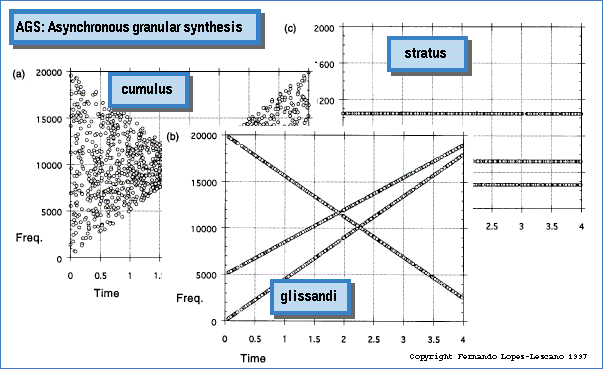 (figure
4)
(figure
4)
depending on the application, the amount of parameters to be applied on the granular synthesis algorithm varies from none (thonk) to hundreds (w????). the following ones you will find in virtually every program:
while in the beginning of the "granular era" the rendering of a piece lasted for days or weeks, nowadays almost every home computer can perform gran. synth. in realtime. therefore it is no longer necessary to write and program scores beforehand, and the technique can be applied to achieve several different goals:
besides complex sound processing
languages like csound or MAX that feature gran. synth., there is also a series
of dedicated programs for this task. an overview over available software without
?????? anspruch auf vollstaendigkeit???? :
| GranuLab
Rasmus Ekman |
PC | Simple Granular syhth program. Only for 16Bit-wav-inputfiles, very easy to use interface, with all parameters as sliders, MIDI-control and 4*16 presets to store. realtime function and disk-rendering. |
| crusher
Jörg Stelkens |
PC | new program for realtime use. very sophisticated programming with 3D-display of the granulation process, yet a bit hard to comprehend. 4 internal oscillators, 4 independent sample-players, realtime input, lots of modulations. |
| Reaktor
Native Instruments |
PC | vast modular Software-Synthesis program with full MIDI-control; offers different granular sample players and a granular delay unit. |
| overSYTE
Ross Bencina |
MAC | ideal for realtime use! 4 sets of parameters can be stored in a 2D-pool for quick interpolation between the 4 settings! |
| Cloud
Generator
Curtis Roads (Pioneer of Gran. Synth) |
MAC | very straightforward program with few parameters,
easy to understand. Allows for interpolating between a start and an end-setting
of the parameters.
|
| Thonk
Arjen v.d. Schoot |
MAC | " Create fresh, unanticipated, flowing or hectic soundfiles
at the *click* of a button, then play them in the background throughout
the day; isn't this great? No composing worries, no sweating blood over
a blank set of staves on your manuscript! *heh* "
preset-based program without possibility to set custom parameters. renders continuously until program is stopped. |
| GrainWave
Michael Berry |
MAC | Max-like interface with less tools. offers grain-sampling-instrument parameters: Stream Freq, Grain Startpos, Grain Length, Grain Freq |
| RTGS
2.0
Marcel Wierckx |
MAC | Sophisticated MAX-application, designed for live-performance. realtime input with short latency, fully MIDI-controllable. 'harmony'-function in the pitch-section for creating chord-like clusters from tonal signals. |